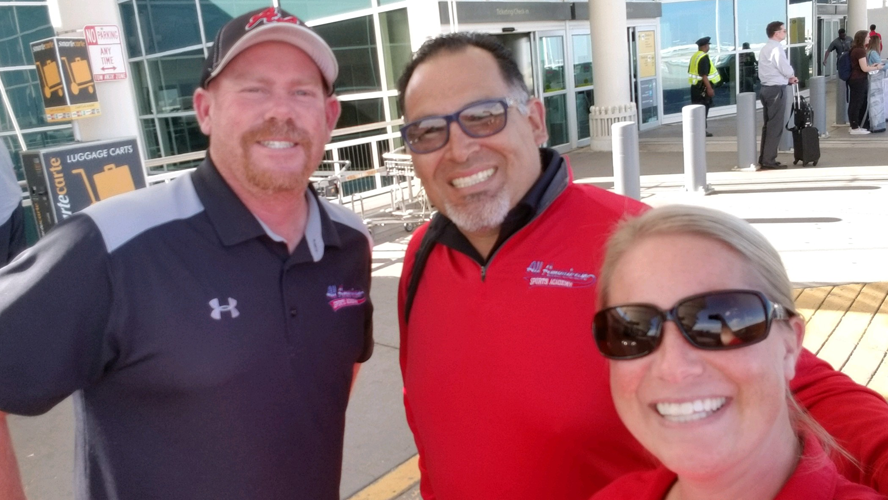|
from left, Charlie Pikas, Jaime Jimenez and TC event director Krista Crawford
The All-American Sports Academy sprang to life through the vision of fastpitch coaching icon Debbie Nelson, who founded the Northern California enterprise 21 years ago. The past 14 years have seen the AASA start and sustain travel teams in softball, showing plenty of muscle in tournament settings and deepening the pool of talented players filling college rosters – the 18 Gold squad is typically one of the strongest rosters in the country (and will play in our Sparkler/Fireworks tournament in 2019). AASA was the fastpitch home of Washington All-American and Team USA member Ali Aguilar. AASA officials/coaches Jaime Jimenez and Charlie Pikas made the trip to Triple Crown’s offices in mid-September and stopped to share some thoughts and perspectives on their club and the shape of the sport. What do you want to make sure parents and players understand about AASA before they suit up for you? JJ: In the very beginning, our priorities were to put kids in college, to give them an opportunity to further their education and play. That was always a starting point that led us to where we are now. We’ve got quite a few college players in our alumni list now, which is pretty cool. CP: We ask parents to support their athletes. It’s not easy playing at the level we try to have our teams play at, so there’s a lot of support needed, most obviously the financial (aspect) and the time. But it’s the mental support, and the physical support of a hug after the tournament. We want them to compete at a high level, and the parents need to get that going in. It’s going to take time away from family vacations in the summer, but your window to be on the journey with these kids is not very long. In the moment, it might seem like you’re giving up a lot, but then you look back and it’s done. The game has evolved so much in the 14 years you all have played travel ball; what jumps out the most about the players in that time? JJ: You’re seeing kids who are in way better shape; they seek out personal trainers, hitting coaches and pitching coaches, more than they did back then. The level of play is so much better with kids starting younger, and we also like the fact they play other sports to be well-rounded. You are a better softball player when you play basketball or field hockey or whatever. But really, the training out there has been a big difference maker in our sport. There aren’t any barriers. CP: It’s what they are capable of … when I started coaching 20 years ago, it felt like fine china, and you didn’t want to break the kids. “Let the girls play, and it’s so cute to watch them…” now, it’s more exciting for me to watch a softball game than a baseball game. What these kids are able to do by allowing them to go out and push themselves and play at that level, it’s exciting. The game is taking off at a great rate, and we hope it continues like that. How do you approach the question of trying to win, while also making sure you are developing players properly? JJ: A lot of my younger teams will hear me say, I’m not that concerned about you winning games. What I’m concerned about is the development; when the winning time comes, usually around when they are 14s or 16s, winning helps the health of the franchise. But you still want to produce terrific kids. It’s a relief you see on the faces of the coaches for our younger kids when I say I’m not worried about you winning. What I want is for them to grow, so when they go to the next age group they can compete, and they’ll keep competing. Winning will come after all the hard work we all put in. It’s a recipe that will work if you trust it and follow it. CP: “Trust the process” is the big catch-phrase right now, but you really have to get parents to understand what your team is, what level you are at and where you’re trying to go, and that they need to be realistic. You lay out that road map in the beginning, and keep that open line of communication going along the way, they can get through the tough times. It’s those coaches who have sole emphasis on winning and you see them get beat down after two or three tough weekends in a row … it starts to affect the team, and then you get parents who are frustrated. So you help the parents along the way, not just the kids, so they all can weather the storm. If a player has a slump in a tournament, it’s not like we are going to give up on that kid, so if we have a tournament where things don’t go well, it’s the same thing. What are some of the goals for AASA heading into the 2019 campaign? JJ: The first thing that’s got us excited is having a 10u team in Seattle; the second part is, I’m completely bought into our youth teams right now. We have some strong young teams, and that’s the future for us at a high-level way. Our older teams are always competing, but we’ve always struggled in the younger ages and I think we’ve cleared that hurdle and will really surprise some people. CP: There’s some transition at the 18 Gold level where we’re seeing some new faces. There’s stuff to be excited about at every level, with some different expectations and excitement levels. |


 RSS Feed
RSS Feed
